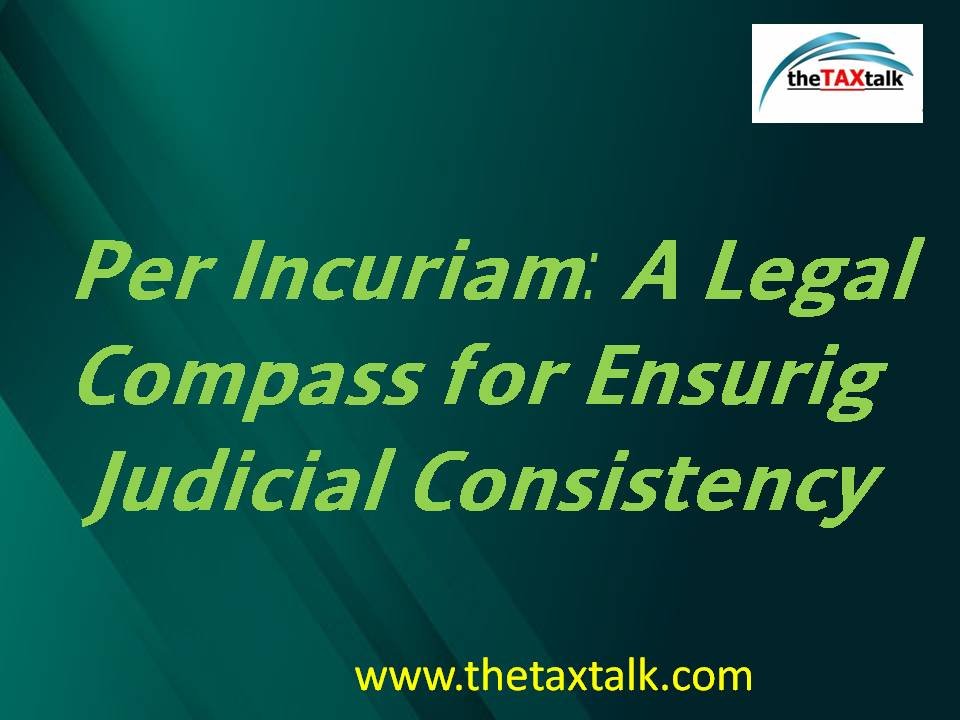![]()
𝗣𝗲𝗿 𝗜𝗻𝗰𝘂𝗿𝗶𝗮𝗺: 𝗔 𝗟𝗲𝗴𝗮𝗹 𝗖𝗼𝗺𝗽𝗮𝘀𝘀 𝗳𝗼𝗿 𝗘𝗻𝘀𝘂𝗿𝗶𝗻𝗴 𝗝𝘂𝗱𝗶𝗰𝗶𝗮𝗹 𝗖𝗼𝗻𝘀𝗶𝘀𝘁𝗲𝗻𝗰𝘆
The recent Constitution Bench (5 judges) in 𝗕𝗮𝗷𝗮𝗷 𝗔𝗹𝗹𝗶𝗮𝗻𝗰𝗲 𝗚𝗲𝗻𝗲𝗿𝗮𝗹 𝗜𝗻𝘀𝘂𝗿𝗮𝗻𝗰𝗲 𝗖𝗼. 𝗟𝘁𝗱. [𝟮𝟬𝟮𝟰 𝗜𝗡𝗦𝗖 𝟴𝟰𝟬] discussed a fundamental yet nuanced doctrine in legal jurisprudence: 𝘱𝘦𝘳 𝘪𝘯𝘤𝘶𝘳𝘪𝘢𝘮. This case provides insights into when a precedent may be labeled per incuriam and how this principle safeguards the sanctity of legal precedents.
𝗨𝗻𝗱𝗲𝗿𝘀𝗮𝗻𝗱𝗶𝗻𝗴 𝙋𝙚𝙧 𝙄𝙣𝙘𝙪𝙧𝙞𝙖𝙢
𝘗𝘦𝘳 𝘪𝘯𝘤𝘶𝘳𝘪𝘢𝘮, Latin for “through lack of care,” applies when a judgment overlooks binding precedent or statutory provisions. This doctrine ensures that judicial decisions respect hierarchical authority and legislative will. It’s not just a technicality—it is foundational to preserving consistency, stability, and fairness in a legal system governed by the rule of law.
𝗞𝗲𝘆 𝗣𝗿𝗶𝗻𝗰𝗶𝗽𝗹𝗲𝘀 𝗖𝗹𝗮𝗿𝗶𝗳𝗶𝗲𝗱 𝗯𝘆 𝘁𝗵𝗲 𝗦𝘂𝗽𝗿𝗲𝗺𝗲 𝗖𝗼𝘂𝗿𝘁
𝟭. 𝗡𝗿𝗿𝗼𝘄 𝗔𝗽𝗽𝗹𝗶𝗰𝗮𝘁𝗶𝗼𝗻: A decision is per incuriam only if it overlooks statutory provisions or binding precedents central to the issue, leading to potentially different outcomes. Mere omissions or failure to cite are insufficient unless they create “glaring obtrusive omissions” or inconsistencies.
𝟮. 𝗥𝗮𝘁𝗶𝗼 𝘃𝘀. 𝗢𝗯𝗶𝘁𝗲𝗿: The doctrine is confined strictly to the ratio decidendi (the legal reasoning essential to the decision) and does not extend to obiter dicta (comments made in passing).
𝟯. 𝗝𝘂𝗱𝗶𝗰𝗶𝗮𝗹 𝗗𝗶𝘀𝗰𝗶𝗽𝗹𝗶𝗻𝗲: When a court doubts a precedent, it should either adhere to it or refer the matter to a larger bench for reconsideration.
𝟰. 𝗘𝘅𝗰𝗲𝗽𝘁𝗶𝗼𝗻𝗮𝗹 𝗠𝗶𝘀𝘀𝘁𝗲𝗽𝘀: The principle applies in cases of demonstrable judicial oversight or inadvertence, particularly when statutes or precedents that contradict the reasoning are plainly ignored.
𝗥𝗲𝗰𝗲𝗻𝘁 𝗧𝗿𝗲𝗻𝗱𝘀 𝗮𝗻𝗱 𝗝𝘂𝗱𝗶𝗰𝗶𝗮𝗹 𝗗𝗶𝘀𝗰𝗶𝗽𝗹𝗶𝗻𝗲
Sometimes, a concerning trend is noted where tribunals and lower courts, seeking to bypass binding precedent, by increasingly invoking per incuriam doctrine by introducing unargued principles. This judgment firmly reins in such tendencies, reinforcing that judicial discipline must be observed to avoid destabilizing the doctrine of precedent.
𝗥𝗲𝗹𝗲𝘃𝗮𝗻𝗰𝗲 𝗶𝗻 𝗧𝗮𝘅𝗮𝘁𝗶𝗼𝗻
Taxation laws frequently evolve through judicial pronouncements which involves complex statutes and precedents. However, a single erroneous judgment—left unchecked—can lead to significant revenue leakage or undue taxpayer hardship.
𝗧𝗵𝗲 𝗥𝗼𝗮𝗱 𝗔𝗵𝗲𝗮𝗱: 𝗚𝘂𝗮𝗿𝗱𝗶𝗻𝗴 𝗔𝗴𝗮𝗶𝗻𝘀𝘁 𝗝𝘂𝗱𝗶𝗰𝗶𝗮𝗹 𝗢𝘃𝗲𝗿𝗿𝗲𝗮𝗰𝗵
This judgment emphasizes the need for judicial coherence and provides a valuable framework for curbing judicial overreach. The doctrine of per incuriam is not merely a technical tool; it is a bulwark against legal uncertainty, ensuring the rule of law remains unshaken.
The copy of the order is as under:

